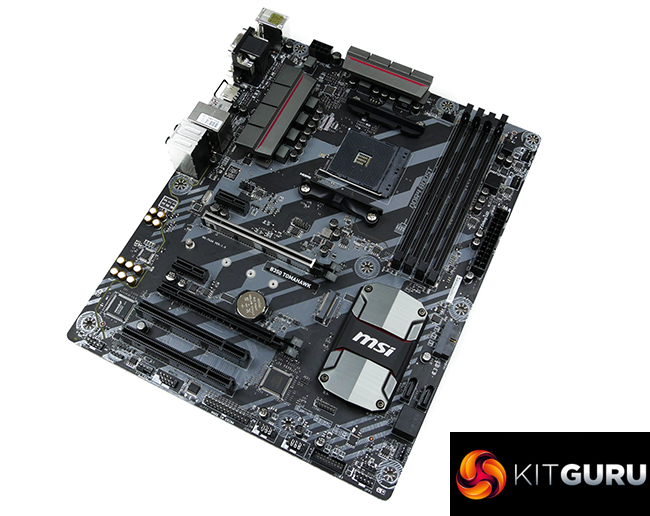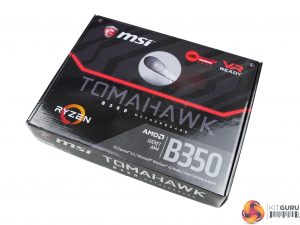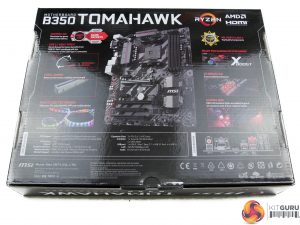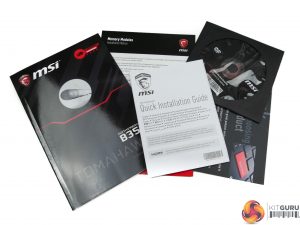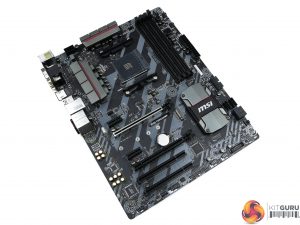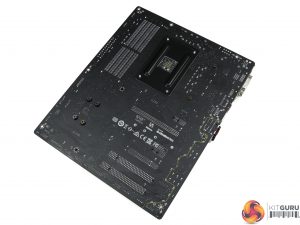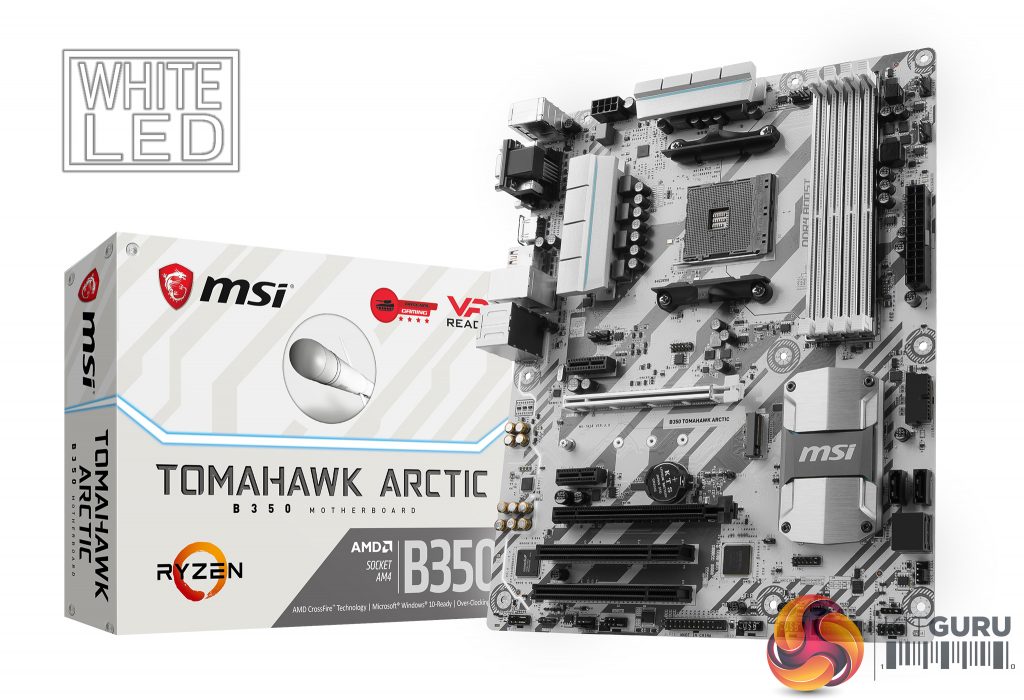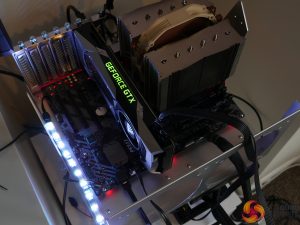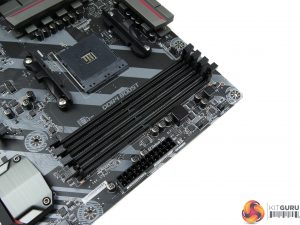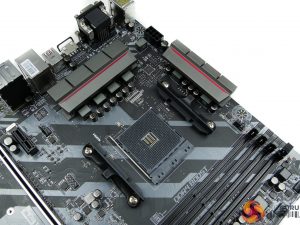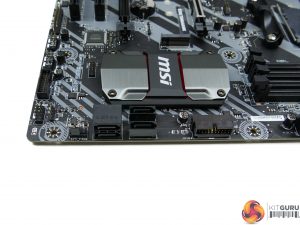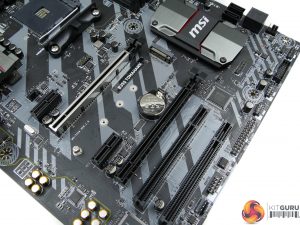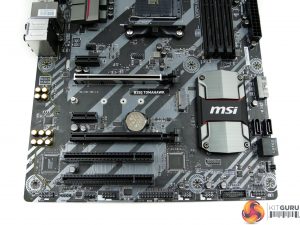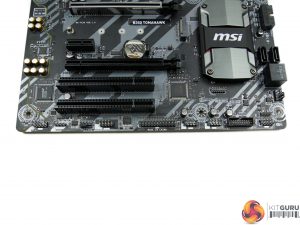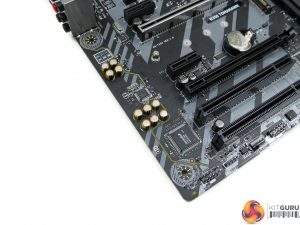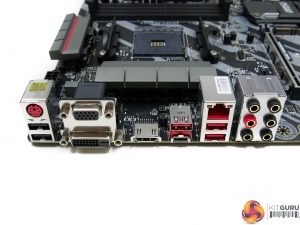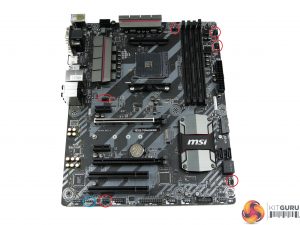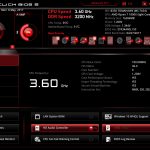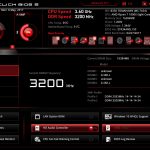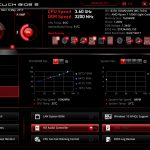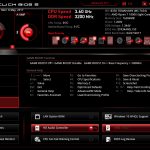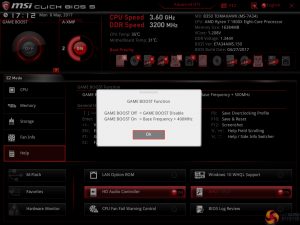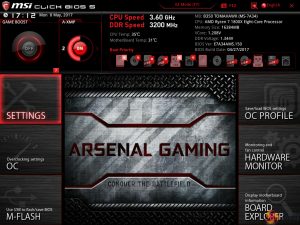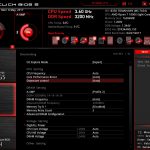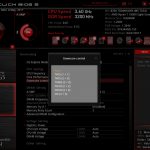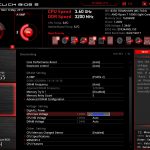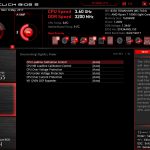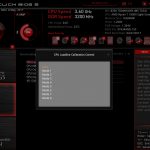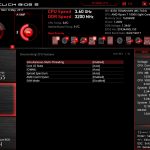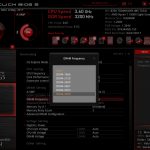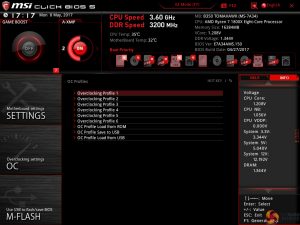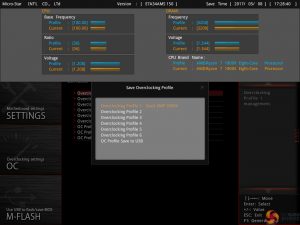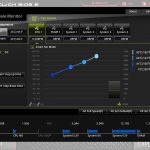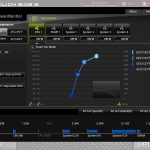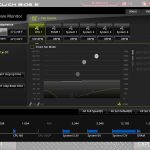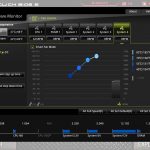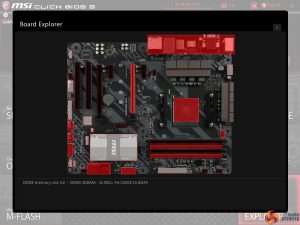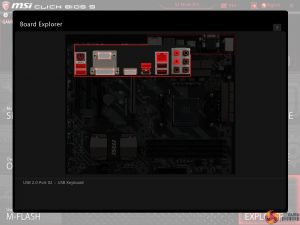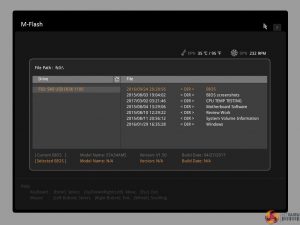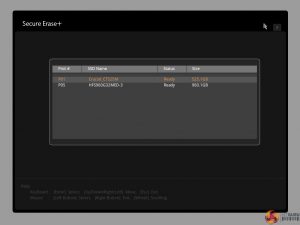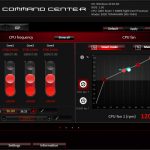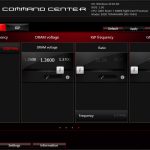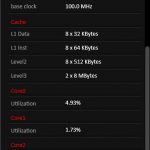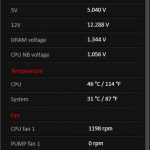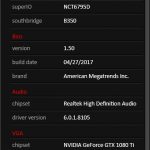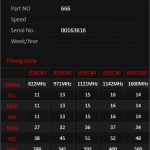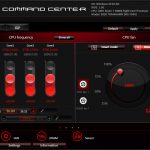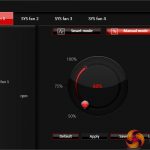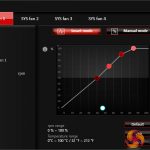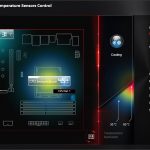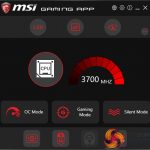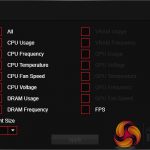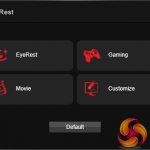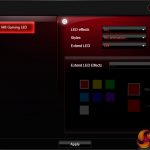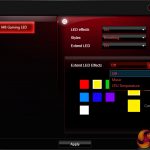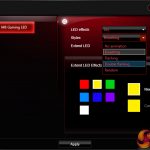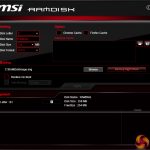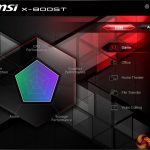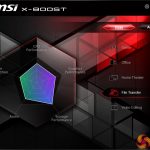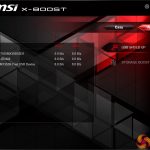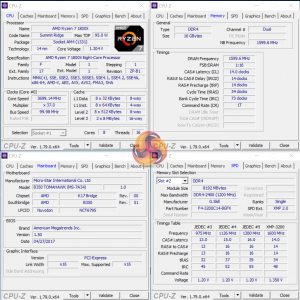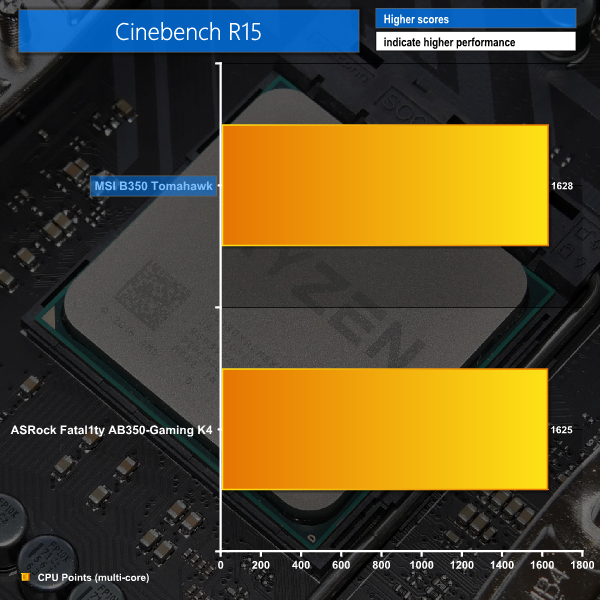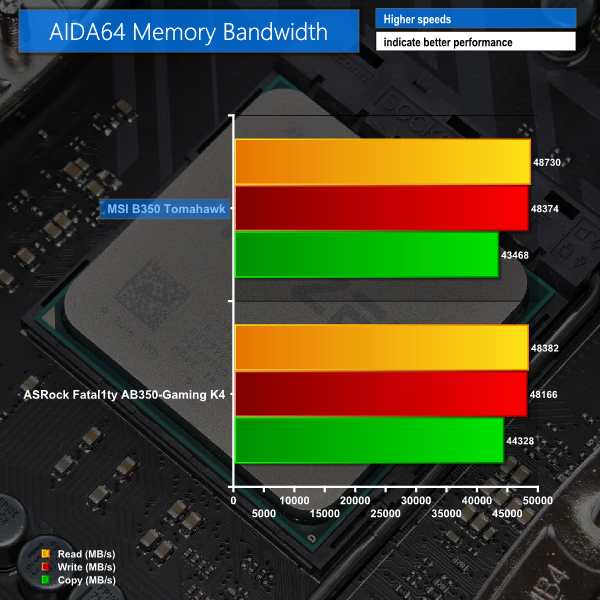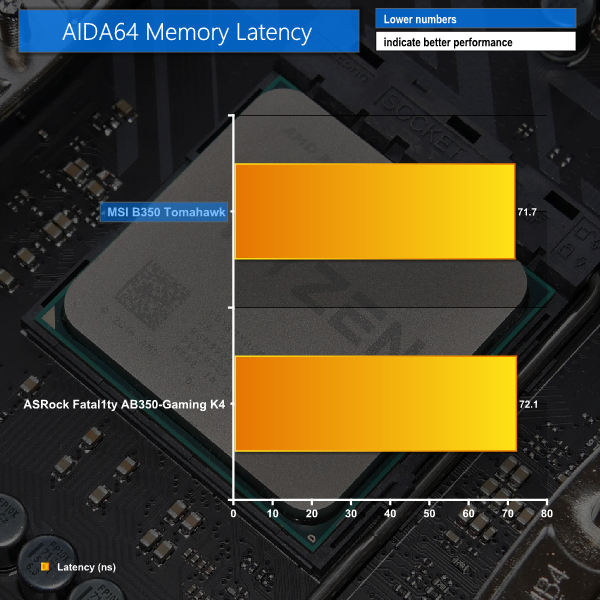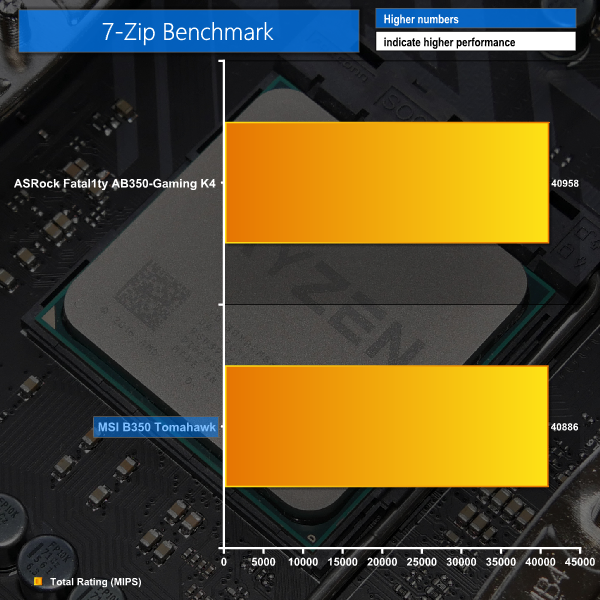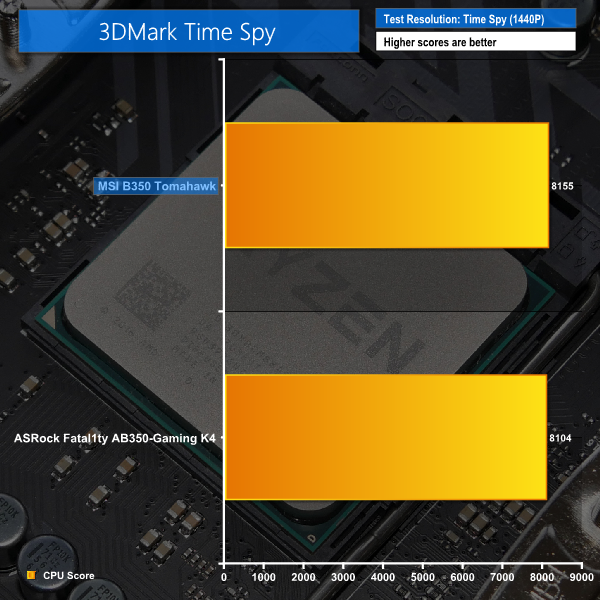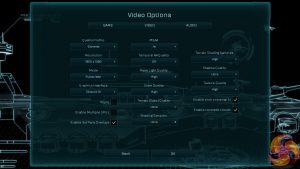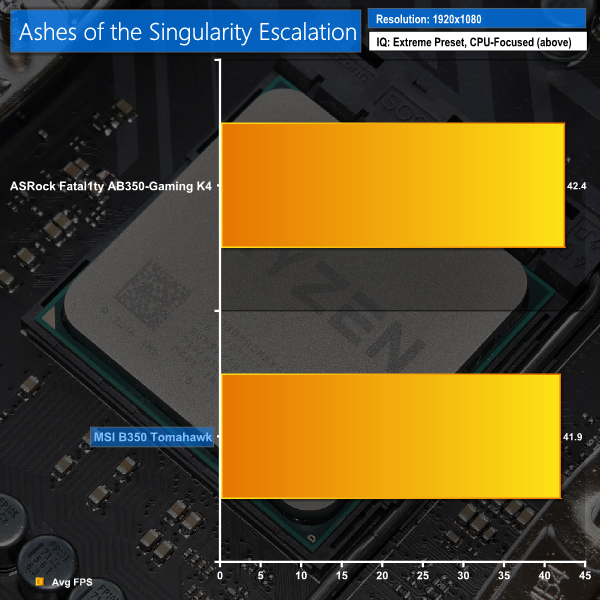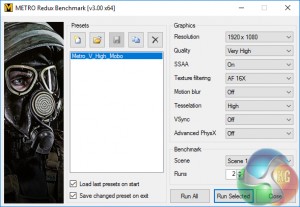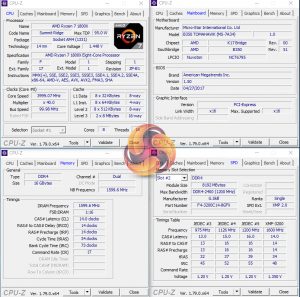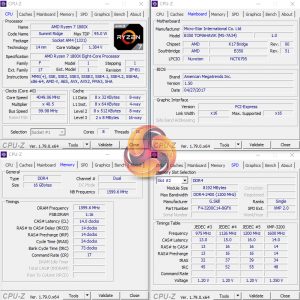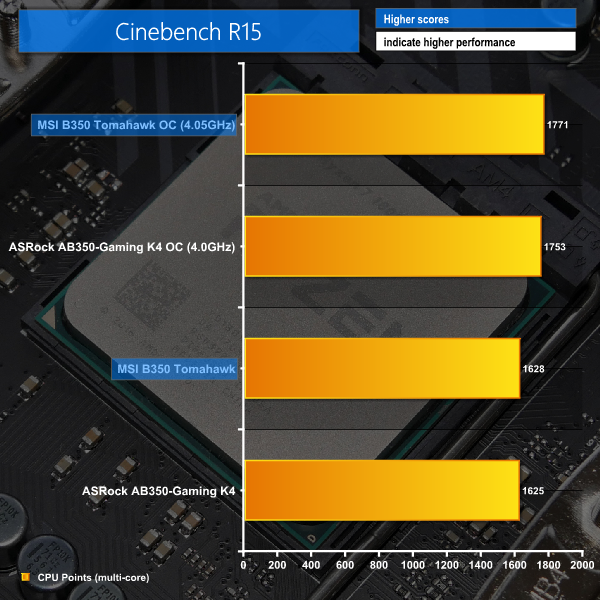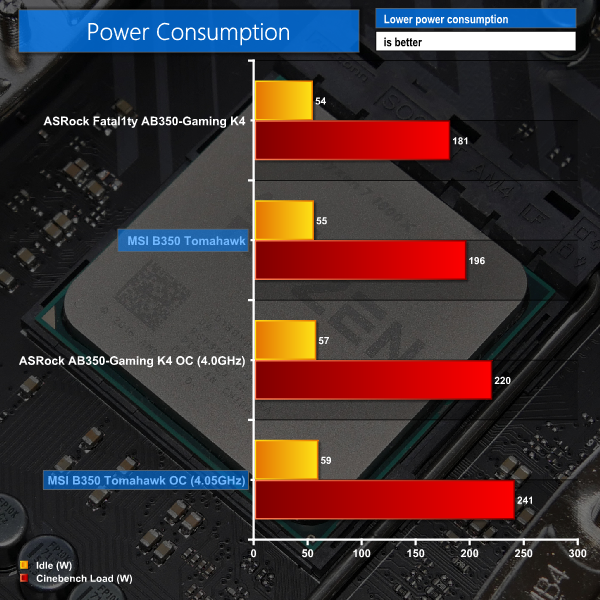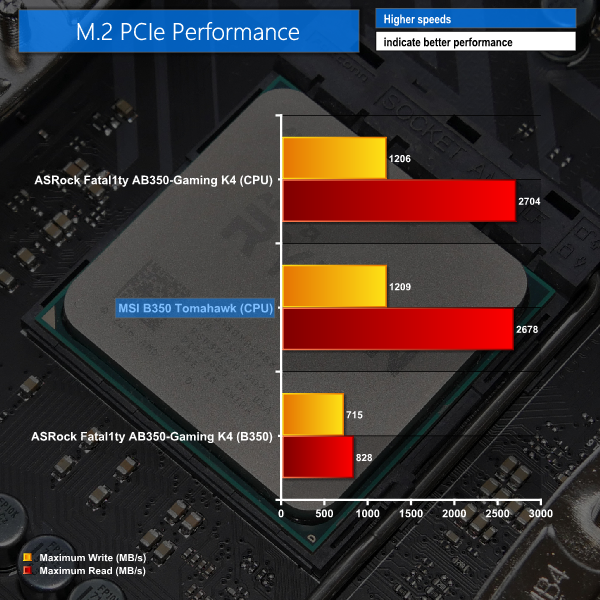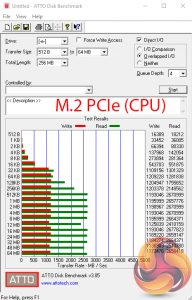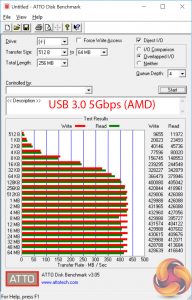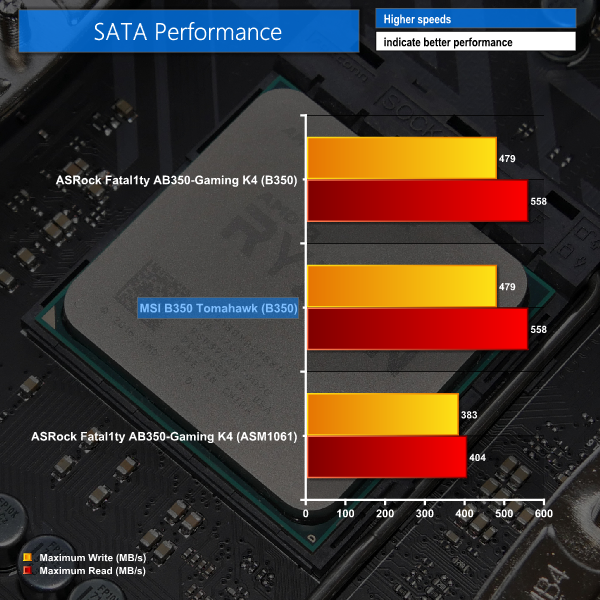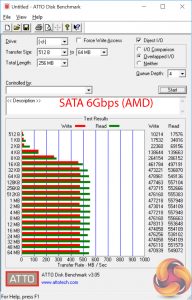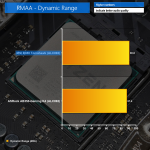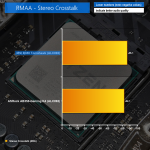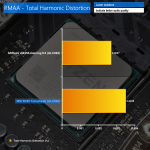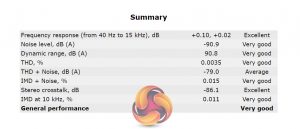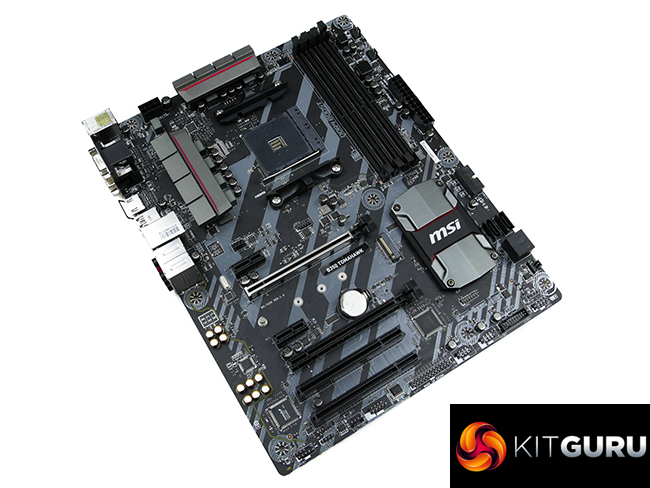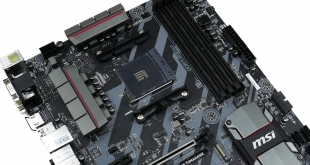
MSI's £100 B350 Tomahawk is the first B350 motherboard to be put through our testing. Retaining the CPU overclocking support that makes the B350 chipset such an alluring option for AM4, MSI outfits its Tomahawk with the key features consumers are asking for, such as USB Type-C and M.2 PCIe NVMe support.
If you are in the market for a Ryzen 5 CPU and plan to overclock, the B350 chipset makes a great deal of sense. MSI knows this and therefore offers budget consumers its B350 Tomahawk which is equipped with a PCIe 3.0 x4 NVMe-capable M.2 slot, USB Type-C (albeit at 5Gbps 3.0 speeds), and a superb fan configuration to cool one's system.
Onboard LEDs are coloured in red but there is a 4-pin strip header to connect external LED strips. Power delivery is handled by four phases dedicated to the CPU and a well-fitted heatsink that takes care of cooling. Support for high-speed memory is an area where MSI offers its one-click A-XMP setting. Game Boost is another one-click setting that allows novice users to apply an overclocked preset at the click of a button.
It is worth highlighting that the B350 Tomahawk and B350 Tomahawk Arctic are both functionally identical except for their colour scheme and onboard LED colour. Read on to find out how the MSI B350 Tomahawk performs.
| MSI B350 Tomahawk | |
| Form Factor | ATX, 30.4 x 24.3 cm |
| CPU Socket | AMD AM4, 4+2 phase VRM |
| Chipset | AMD B350 |
| Memory | DDR4 Dual channel, 4 DIMMs, up to 64GB, up to 3200MHz+ with OC (with a Ryzen CPU) |
| Onboard Graphics |
VGA, DVI-D, and HDMI ports for use with AM4 APUs |
| Expansion Slots | 1 x PCIe 3.0 x16 (x16 for Ryzen, wired to the CPU), 1x PCIe 2.0 x16 (x4 mode, wired to the chipset), 2x PCIe 2.0 x1 (wired to the chipset), 2x PCI |
| Storage | 4 x SATA 6Gbps (via B350 chipset) 1 x M.2 SATA (6Gbps) or NVMe PCIe 3.0 x4 (with Ryzen CPUs) or PCIe 3.0 x2 (with AM4 APUs) |
| USB | 6 x USB 2.0 (4 Internal, 2 Rear, via B350) 7x USB 3.0 (4 Internal via B350, 3 Rear, via CPU) 1x USB 3.0 Type-C (1 Rear, via CPU) |
| Networking | 1 x Realtek 8111H Gigabit LAN |
| Audio | Realtek ALC892-based 7.1 channel HD audio |
| Fan Headers | 6, all support 3/4pin fans and DC/PWM mode |
| RGB Headers | 1, 4-pin RGB |
| Rear I/O | 1 x PS/2 mouse & keyboard combo port 2 x USB 2.0 ports 1 x VGA 1 x HDMI 1 x DVI-D 3x USB 3.0 Type-A port 1x USB 3.0 Type-C port 1 x LAN (RJ45) port 6x OFC audio jacks |
| UEFI BIOS |
MSI Click BIOS 5 UEFI |
The MSI B350 Tomahawk ships in a box that outlines the features on the rear side with an image of the motherboard.
Bundled items are representative of a budget offering – you get two SATA cables and the labelled rear IO shield. Documentation is the usual affair but I did not find an MSI-branded case sticker with our sample.
The MSI B350 Tomahawk uses a dark grey and black colour scheme to fit into MSI's Arsenal range of products that is targeted towards more beginner-level gamers (not that it makes any difference to actual gaming performance).
Two heatsinks of decent size are used to cool the VRM components. Credit to MSI for using a sturdy screw-tightened mounting method for the VRM heatsinks. This is a significant improvement over the push-pin alternative seen on low-cost motherboards that delivers poor mounting pressure for the VRM heatsinks.
If the black and grey theme is not appealing to you, MSI offers its B350 Tomahawk Arctic at an identical price point to the normal B350 Tomahawk. The Arctic uses a white and black colour scheme and white LEDs. Other than the style change, there are no differences between the two models so the performance figures and analysis points are interchangeable.
Onboard lighting for the motherboard is intentionally coloured red. This colour cannot be changed in the software but it can be set to operate in a different mode or turned off completely. The B350 Tomahawk Arctic uses a white LED system, rather than red, in order to fit with its wider styling approach.
MSI supports 4-pin RGB strips but it is somewhat misleading for the company to claim ‘RGB' capability. A connected 4-pin LED strip can only be set to operate using one of MSI's seven pre-determined colour options. There's no real RGB control that allows a user to customise the LED colour with granular control over the 16.7 million colour options.
You basically get an LED strip connector that can be set to one of seven colours rather than true, customisable RGB mode.
MSI advertises support for DDR4 memory speeds over 3200MHz via overclocking. We were able to successfully use our 3200MHz G.SKILL Flare X kit using the board's A-XMP setting. This is largely thanks to the memory ICs used by G.SKILL that work favourably with Ryzen.
Four memory slots allow for up to 64GB of DDR4 to be installed. I like the pure black colour of the slots. Nearby are the 24-pin power connectors and two 4-pin fan headers, one of which is pre-assigned water pump duties but can be speed controlled in the UEFI.
MSI uses a 4+2 phase power delivery system to feed the AM4 CPU and its accompanying components such as the SOC voltage rail and (probably) iGPU for upcoming APUs.
A Richtek RT8894A PWM controls the system. Four CPU phases use four NIKOS PK616BA and eight NIKOS PK632BA MOSFETs, in addition to a component marked ‘4P=3H V38' that I could not find information for but is likely a MOSFET driver. The 2-phase SOC power is handled by four NIKOS PK616BA and four NIKOS PK632BA MOSFETs, in addition to a pair of the aforementioned ‘4P=3H V38' components likely to be MOSFET drivers.
This is a decent enough power delivery solution for a roughly £100 AM4 motherboard. The primary MOSFETs are the same type used on MSI's £300 flagship X370 XPower Gaming Titanium motherboard. That point can be interpreted as a good thing for the B350 Tomahawk or a bad thing for the £300 XPower.
Despite the B350 chipset offering the capability for up to six SATA ports, albeit by stealing bandwidth from elsewhere, MSI only deploys four SATA 6Gbps connectors on the B350 Tomahawk. This is a slim amount that I have not seen on a motherboard outside of the mini-ITX form factor for many, many years. Most competing solutions even at this price point offer six or more SATA ports.
Put into perspective, however, four SATA 6Gbps ports plus an M.2 slot is likely to be sufficient for most people buying a £100 motherboard. There's no denying that it will be borderline to some users, though.
The single 110mm-capable M.2 connector supports M.2 32Gbps PCIe 3.0 x4 NVMe SSDs as well as SATA 6Gbps-based alternatives. MSI does not include its M.2 Shield cover with this motherboard. The M.2 slot's positioning below the primary graphics card slot means that it will receive incidental airflow from an open air heatsink found on many board partner graphics cards. It also means that an ugly green PCB on an M.2 SSD will be hidden.
The steel-reinforced PCIe slot is where sixteen PCIe 3.0 lanes from an AM4 Ryzen CPU are directed and should be used to install a graphics card. Four PCIe 2.0 lanes from the chipset are delivered to the secondary full-length slot, making it unsuitable for SLI or high-bandwidth CrossFire. Two PCIe 2.0 x1 slots are also provided and receive their bandwidth by stealing some lanes from the lower full-length slot, which is then dropped from x4 to x2 mode.
MSI uses an ASMedia ASM1083 PCIe-to-PCI bridge chip to provide the legacy PCI connectivity. This adds slight cost to the motherboard's bill-of-materials but may be worth it for budget customers looking to recycle older peripheral cards.
One of the two internal 5Gbps USB 3.0 headers is positioned along the bottom edge, with the other residing near the SATA ports in a right-angled mount.
An ageing Realtek ALC892 audio codec is used as the heart of the B350 Tomahawk's audio system. This is a clear cost-cutting decision deployed to help the board hit its roughly £100 retail price point but it is one that is common across motherboard vendors in this market segment. A sizeable quantity of Nippon audio capacitors aid the solution.
MSI's B350 Tomahawk is compatible with Nahimic 2 audio software.
A total of five USB Type-A ports is found on the rear IO, alongside one Type-C port provided by the ASMedia ASM1543 logic controller. Two of the ports are USB 2.0 and should serve for peripheral duties alongside the PS/2 connector. The remaining four USB ports (three Type-A and one Type-C) all run at 5Gbps USB 3.0 bandwidth.
I would have liked to see a couple more USB Type-A ports to boost connectivity options. The lack of 10Gbps USB 3.1 Gen 2 is disappointing but not uncommon in this price point – both ASRock and ASUS drop the 10Gbps link on their competing models.
DVI-D, HDMI, and VGA form the rear IO video outputs. VGA is provided by an IT6516BFN converter. Resolutions up to 1920×1200 at 60Hz are supported on the single-link DVI-D port, while HDMI offers 4K at a low refresh rate or lower resolutions (such as 1080P) at 60Hz. These ports are only useable with an AM4-based APU, not a Ryzen processor.
Gigabit Ethernet is provided by the Realtek 8111H chipset that is a cheaper alternative to Intel and Killer NICs found on more expensive motherboards. Credit to MSI for providing the full cohort of 3.5mm audio jacks, despite dropping the optical SPDIF port in the process.
Overall, MSI has a good selection of rear IO ports that offers a slightly better balance than some of its similarly priced competitors.
Six 4-pin fan headers are spread around the motherboard, with four being within reach of the CPU socket. This is a superb number of fan headers for MSI to include on a budget motherboard. The flexibility for the headers to control PWM or DC fans gives a user plenty of options when connecting their system's cooling components.
The single 4-pin RGB header is located in the board's bottom-left. This location suits users who want to install a floor-mounted LED strip but those looking for a roof installation will need to purchase an extension cable (that is not included by MSI). Nuvoton's NCT6795D-M chipset is deployed for monitoring duties.
MSI B350 UEFI
The UEFI used by MSI is almost identical across its current product range. As such, we have re-used the bulk of our analysis from previous MSI reviews and updated the text where there are subtle differences.
Firstly, we are pleased to report that our generic wireless mouse worked correctly in the UEFI. Some mice can be troubling with UEFI support, so when a generic wireless unit functions correctly in the interface, that is usually a good sign for overall mouse support.
Entry into MSI’s Click BIOS 5 UEFI is started on the EZ Mode page.
MSI’s version of EZ Mode is the best of all motherboard vendors as it features the most options but does not overcrowd the screen and remove the ease-of-use aspect. Buttons for simple A-XMP and Game Boost overclocking activation are smart moves.
Game Boost is MSI’s pre-determined overclocking mode which offers frequency adjustments for Ryzen CPUs. These are far less fine-tuned than manual overclocking, though, as they are designed to work with a variety of chips rather than your own specific silicon.
Hitting F7 takes a user into the Advanced section. The general layout is well-described and easy to follow. Six tabs house all of the adjustable settings, with information and boot device adjustment being held at the top of the page.
The OC section is, as expected full of settings relating to overclocking. MSI smartly includes a Normal or Expert selection mode that is useful for those trying to learn about overclocking who do not want to risk adjusting irrelevant settings.
There is an adequate number of options relating to voltage, frequency, and settings adjustments and all are generally easy to find. However, if you want great flexibility for granular settings control, an X370 motherboard is the better option as the B350 models are more limited in this department. Being critical, the layout could be a little more segregated to reduce the amount of information on the single primary page.
Unlike the X370 alternatives, MSI’s load-line calibration (LLC) settings for B350 are unclear. Nine different options can be selected but MSI chooses not to deploy its simple graph to show how the voltage changes based on load. The graph would have aided the simplicity of our overclocking attempts but instead we had to resort to a trial and error approach.
Options are also allocated for memory. Dividers up to 32x for 3200MHz can be selected, which is ideal for aiding flexibility to overclockers who are pushing their system with high-speed RAM. A-XMP is basically MSI’s way of loading up an XMP configuration on its AMD motherboards. This was a hassle-free, stable process using our 3200MHz G.SKILL Flare X memory modules.
Up to six individual settings profiles can be saved to the board and more can be transferred using storage mediums. Pressing F8 and F9 on a main page of the UEFI draws down an overclocking profile tool which allows for saving and loading.
This tool is a superb graphical method of displaying how the system will change compared to its current state. It would be great to see MSI also roll this out to the more mundane OC Profile section. Either way, the graphical display is certainly a positive for MSI’s UEFI over its competitors’.
Hardware Monitor is where the primary fan control actions take place. PWM and DC control modes are selectable. MSI keeps in-built fan speed presets to a bare minimum and instead relies on its good graphical control method.
A 4-point curve can be used to adjust the fan speed profile based on temperature readings from the CPU or system. Fan speed adjustments take place in real time which is ideal for tuning the system noise output more efficiently.
The ability to run fans at 0% up to a user-defined temperature level is a strength for MSI and speed hysteresis control is good to have. However, the fact that only CPU and System temperature sensor data can be read is slightly disappointing albeit understandable in this price range. Higher-end offerings from competing vendors provide the ability to drive a fan curve based on data from multiple temperature sensors, not just the CPU or System.
I like the written information that MSI displays alongside the graph, such as exact fan speed percentages and temperatures for each marker.
Board Explorer is a visual interpretation of the motherboard and its connected devices. This is a valuable tool to use for troubleshooting or ensuring that components are connected to the correct port at the correct speed. This is like ASRock’s System Browser tool.
M-Flash has an ability to select BIOS profiles in USB drive folders, which is good. The tool works without hassle.
Secure Erase is a relatively new addition to MSI’s UEFI. The tool can be used to securely wipe (not just format) an SSD with great ease which can be good if selling it on or aiming to restore performance from a ‘dirty’ drive. I used this tool successfully with a SanDisk SSD on one of MSI’s Z270 motherboards.
UEFI Summary:
MSI’s Click BIOS 5 UEFI is a great offering without any glaring weaknesses. The EZ Mode page is market-leading, ease of navigation is high despite the crowded OC page, and tools such as Secure Erase and Board Explorer sweeten the deal. I found mouse support to be strong but the visual interpretation of the LLC settings found on MSI's higher-end SKUs is missed.
Manual fan control is good but the lack of preset profiles and fewer temperature sensors prevents MSI from being a clear winner against its competitors in this department. Save slots for six system profiles is sufficient and the alternative mode by which these profiles can be selected is extremely intuitive.
The lack of RGB LED control options through the UEFI is disappointing. UEFI settings for LEDs can be retained in the event of an OS crash or reinstall. Despite this, MSI’s UEFI is a strong offering that should serve the clear majority of users well.
Software
The software used for MSI's motherboards is almost identical across its product range. As such, we have re-used the bulk of our analysis from previous reviews and updated the text where there are subtle differences.
Command Center is the bread-and-butter of MSI’s OS-based software tools. Primary functionality of the system can be controlled here, including adjustment of multiplier ratios, clocks and voltages, and MSI’s Game Boost overclocking preset.
Break-out tabs display information and adjustment options for voltages, ratios, and fan speeds. DRAM timings also get their own break-out page.
Fan tuning options in Command Center are good. There is an auto fan tuning mode which allows the system to adjust the fan speed curve to its perceived optimal design. User adjustment of the fan speed curves is also possible using a 4-point graph.
MSI’s temperature sensor page is good although the number of reading points is limited to just two – the CPU and system. This page also shows which fans are connected and a temperature illustration can be set to give visual interpretation of system behaviour.
Gaming App is used to control several different operating modes for the system. Three pre-set modes are available – Gaming, OC, and Silent. The OC mode applies Game Boost, as it is called in the UEFI.
There’s an OSD to display system information but it is far less in-depth than RivaTuner that is supplied with MSI Afterburner. A monitor’s colour profile can be adjusted to reduce eye-strain or blue light. There’s also an option for remote control of the system settings.
The LED section of MSI’s Gaming App is where most users are likely to be spending their time. Individual control is given to the lighting section of the motherboard and the 4-pin RGB header. There is also an option to completely switch off all LED lighting.
Different lighting modes can be activated, including breathing, flashing, and random behaviour. The lights can also be set to behave in a manner that is associated with different styles of music – for example, the rap mode flashed as if it was following the repetitive backing tune of a rap song.
MSI’s lighting options in the OS software are very weak terrible compared to ‘Carbon' branded SKUs from MSI as well as competing options from the likes of ASRock. MSI does not even include a method for truly controlling the RGB colour of an attached strip, instead forcing a user to choose between seven pre-determined colours with no mixing or customisation opportunities available.
Of course, there is the option for a consumer to step up to one of MSI's more expensive ‘Carbon' models if RGB customisation is deemed important. That's a poor decision from MSI that really doesn't make sense when comparably-priced ‘Gaming' branded solutions offer stellar RGB customisation to users. ASRock's similarly-priced Fatal1ty AB350-Gaming K4, for example, offers proper RGB control for an RGB strip in its software.
The solution for MSI is likely to be a simple adjustment to the OS-based software with negligible cost implication. Unfortunately, the plausible simplicity of such a solution is possibly the reason why the RGB LED feature looks to have been intentionally disabled by MSI.
Poor show, MSI.
Gaming LAN Manager is essentially MSI’s in-house software that allows the vendor to use a non-Killer NIC whilst retaining some of the control features typically associated with Killer-based offerings. The main benefit is enhanced information delivery so that a user can understand how their system’s network-interacting software is behaving. There’s also an ability to prioritise applications such as games.
MSI’s RAMdisk does what the title says. The RAM disk size can be set up to a high percentage of system memory. The tool also includes options to restore the RAM disk upon boot, back it up to a non-volatile storage device, and set advanced cache for certain options.
X-Boost features several system operation modes that use tweaked settings. There are presets for operations such as gaming and video editing. The game mode sets all performance metrics to a high importance while the video editing mode emphasises parameters important to such a task.
There is also the ability to speed up USB and storage devices. We have previously tested X-Boost with other motherboards and found it to offer little benefit to storage devices other than those based on USB 3.1 Gen 2.
OS Software Summary:
It would be a significant understatement to say that MSI includes a sizeable number of in-depth software tools. The separate software pages are vast and options are plentiful. I particularly like the extremely in-depth Command Center.
MSI’s RGB lighting control tool is sub-par on the Tomahawk SKU as MSI is clearly trying to push RGB aficionados towards ‘Gaming' branded models. I would have also liked to see a software manager app like App Center by Gigabyte and AI Suite by ASUS. A lot of software means a lot of shortcuts or location to manage – one umbrella utility would aid ease of navigation to different software offerings.
Overall, MSI’s variety and quality of OS-based software apps is good but the RGB control for the Tomahawk model is severely limiting.
We will be outlining the MSI B350 Tomahawk motherboard’s performance with the Ryzen 7 1800X CPU and 16GB of 3200MHz G.Skill Flare X DDR4 memory.
Stock voltage hovered around 1.3V under Cinebench load. This was using the latest v1.50 BIOS.
AM4 Motherboard Test System:
- Processor: AMD Ryzen 7 1800X (3.6-4.0GHz + 4.1GHz XFR).
- Memory: 16GB (2x8GB) G.Skill Flare X 3200MHz 14-14-14-34 DDR4 @ 1.35V.
- Graphics Card: Nvidia GTX 1080 Ti Founder's Edition (custom fan curve to eliminate thermal throttling).
- System Drive: 525GB Crucial MX300 SATA 6Gbps SSD.
- Games Drive: 960GB SK Hynix SE3010 SATA 6Gbps SSD.
- CPU Cooler: Noctua NH-D15.
- Power Supply: Seasonic Platinum 760W.
- Operating System: Windows 10 Pro 64-bit (Creators' Edition).
Comparison AM4 Motherboards:
- ASRock Fatal1ty AB350-Gaming K4.
Software:
- MSI B350 Tomahawk BIOS v1.50 (latest).
- GeForce 381.89 VGA drivers.
Tests:
- Cinebench R15 – All-core CPU benchmark (CPU)
- HandBrake 1.0.7 – Convert 6.27GB 4K video recording using the Normal Profile setting and MP4 container (CPU)
- SiSoft Sandra 2017 – Processor Arithmetic Test (CPU).
- AIDA64 Engineer 5.90 – Memory read, write, copy, and latency tests (Memory)
- 7-Zip 16.04 – Built-in 7-Zip benchmark test (CPU & Memory)
- 3DMark Time Spy – CPU score (Gaming)
- Ashes of the Singularity Escalation – Built-in benchmark tool CPU-Focused test, 1920 x 1080, Extreme quality preset, DX12 version (Gaming)
- Metro: Last Light Redux – Built-in benchmark tool, 1920 x 1080, Very High quality, SSAA, AF 16X, Tessellation: High (Gaming)
- ATTO – M.2, USB 3.0, USB 3.1, and SATA 6Gbps transfer rates (Motherboard)
- RightMark Audio Analyzer – Record and playback test using a line-in to line-out loopback with a 3.5mm audio cable (Motherboard)
Cinebench R15
Cinebench is an application which renders a photorealistic 3D scene to benchmark a computer’s rendering performance, on one CPU core, all CPU cores or using the GPU. We run the test using the all core CPU mode.
Handbrake Conversion
Handbrake is a free and open-source video transcoding tool that can be used to convert video files between different codecs, formats and resolutions. We measured the average frame rate achieved for a task of converting a 6.27GB 4K video using the Normal Profile setting and MP4 container. The test stresses all CPU cores to 100% and shows an affinity for memory bandwidth.
SiSoft Sandra Processor Arithmetic
SiSoft Sandra is a multi-function utility program that supports remote analysis, benchmarking and diagnostic features for PCs, servers, mobile devices and networks. We run the application’s processor arithmetic test to gauge the CPU performance on each tested motherboard.
CPU-based performance from MSI's B350 Tomahawk is right on point. No performance concerns here.
AIDA64 Memory Throughput
AIDA64 is a multi-featured software suite for diagnostics, stress testing, benchmarking, software auditing and various other measurement parameters. We use AIDA64 Engineer to benchmark memory throughput and latency.
AIDA64 Memory Latency
AIDA64 is a multi-featured software suite for diagnostics, stress testing, benchmarking, software auditing and various other measurement parameters. We use AIDA64 Engineer to benchmark memory throughput and latency.
7-Zip
7-Zip is an open source Windows utility for manipulating archives. We measure the Total Rating performance using the built-in benchmark tool. The test stresses all CPU cores to 100% and shows an affinity for memory bandwidth.
Memory performance is comparable to a similarly-priced competing motherboard from ASRock.
3DMark
3DMark is a multi-platform hardware benchmark designed to test varying resolutions and detail levels of 3D gaming performance. We run the Time Spy benchmark, which is indicative of high-end 1440p PC Gaming with the DX12 API.
Ashes of the Singularity Escalation
Ashes of the Singularity is a Sci-Fi real-time strategy game built for the PC platform. The game includes a built-in benchmark tool and was one of the first available DirectX 12 benchmarks. We run the CPU-focused benchmark using DirectX 12, a 1080p resolution and the Extreme quality preset.
Metro: Last Light Redux
Despite its age, Metro: Last Light Redux remains a punishing title for modern computer hardware. We use the game's built-in benchmark with quality set to Very High, SSAA enabled, AF 16X, and High tessellation.
MSI's B350 Tomahawk will be a solid choice for a gaming system, despite not having ‘Gaming' in its title.
Automatic CPU Overclocking (UEFI-Based):
MSI Game Boost overclocking preset adds 400MHz to the base clock of your chosen CPU. In our test case, that took the 1800X to 4.0GHz on all cores. MSI, thankfully, maintains A-XMP operation but the CPU voltage is left at ‘auto' and the CPU cooler's fan speed is ramped up. This results in a load voltage of just under 1.45V for our 1800X to maintain 4.0GHz stability.
While 1.45V is a logical voltage level that should ensure stability with the vast majority of Ryzen chips up to 4.0GHz, it is also a high voltage level for use by less-experienced overclocking users who will gravitate towards a one-click overclocking solution.
I would advise using MSI's Game Boost overclock only with a capable cooling solution, given the high voltage level applied.
Manual CPU Overclocking:
To test the MSI B350 Tomahawk motherboard’s CPU overclocking potential, we aim to set the CPU voltage close to 1.40V. CPU VCore is set to 1.40V and we applied the Mode 4 LLC setting. NB voltage was not adjusted and there is no option to change SOC voltage in the MSI UEFI.
We maintained the DRAM frequency at 3200MHz to take its stability out of the overclocking equation.
Our chosen settings saw MSI's B350 Tomahawk taking our 1800X to its 4.05GHz limit with around 1.40V. The Mode 4 LLC setting resulted in a load voltage of 1.384V, which is a decent level of accuracy for this calibre of motherboard and did not negatively impact stability.
Overclocked Performance
As a performance comparison, we have included the results from ASRock's Fatal1ty AB350-Gaming K4 motherboard. The maximum overclocked configuration achieved with the ASRock board was a 4000MHz (40.0 x 100MHz) processor frequency whilst using 3200MHz CL14 memory.
The voltage accuracy and LLC capability of MSI's B350 Tomahawk make it a vastly more controllable overclocking product than ASRock's competing Fatal1ty AB350-Gaming K4. This enhanced control for MSI's part allowed it to extract the final 50MHz of clock speed from our 1800X and deliver better performance than ASRock's competitor.
Power
We leave the system to idle on the Windows 10 desktop for 5 minutes before taking a reading. For CPU load results we run Cinebench multi-core and take a reading. The power consumption of our entire test system (at the wall) is shown in the chart.
Power draw from the MSI B350 Tomahawk is on the high side due to aggressive voltage tuning. Stock-clocked load voltage is quite high at around 1.3V with an 1800X. The improved accuracy compared to ASRock's offering allowed MSI's board to extract more performance from our 1800X which in turn required greater power draw.
ATTO Disk Benchmark
The ATTO disk benchmark is a Windows-based utility for testing storage performance of any storage drive or controller. We use the default benchmark setup.
M.2 PCIe Performance
For M.2 testing we use a Toshiba OCZ RD400 256GB M.2 PCIe NVMe SSD.
No problems with the PCIe M.2 performance from the single port on MSI's B350 Tomahawk. This slot is fed directly by an AM4 CPU and MSI chooses not to add a second M.2 slot that is driven by chipset-based lanes.
The lack of cooling for an M.2 SSD may lead to throttling when used with a hot M.2 device such as the Samsung 950 Pro.
USB 3.0 5Gbps & USB 3.1 Gen 2 10Gbps Performance
We test USB 3.0 5Gbps and USB 3.1 Gen 2 10Gbps performance using a pair of Corsair Force LE 120GB SSDs in RAID 0 connected to an Icy Box RD2253-U31 2-bay USB 3.1 enclosure powered by an ASMedia ASM1352R controller.
MSI trails ASRock in the USB 3.0 5Gbps transfer rate department. There is no USB 3.1 Gen 2 10Gbps connectivity on the B350 Tomahawk, meaning that transfer rates of around 430MBps are as fast as it gets for external connectivity.
MSI's X-Boost utility did not improve USB 3.0 5Gbps transfer rates in our testing. This is disappointing as we have seen the software improve USB 3.1 Gen 2 transfer speeds on other motherboard models from MSI.
SATA 6Gbps Performance
For SATA 6Gbps testing we use a SK Hynix SE3010 960GB SSD.
Performance from the AMD-based SATA 6Gbps ports is right where it should be. MSI does not equip the B350 Tomahawk with an add-on SATA controller to increase its onboard port count.
Audio
Rightmark Audio Analyser is a freeware benchmarking utility designed to objectively test the performance characteristics of audio solutions. We setup a line-in line-out loop and execute the record/playback test before generating the results report you see below. A sampling mode of 24-bit, 192 kHz was tested.
Audio performance from the B350 Tomahawk is overall ‘very good' according to RMAA. MSI's solution looks to be slightly superior to that of ASRock's in some of the key metrics.
The MSI B350 Tomahawk is a well-optimised AM4 motherboard that takes advantage of AMD's B350 chipset and smart cost-cutting decisions to offer a superb balance of features and performance.
Performance from the motherboard was good and we had no problems overclocking a power-hungry Ryzen 7 1800X to past 4GHz. The four power delivery phases for the CPU were stressed heavily with such a task which resulted in significant heat being dispersed by the VRM heatsink. However, this represents a solid stress test for the B350 Tomahawk that proves its ability to work with the most powerful Ryzen processor available.
MSI's UEFI is easy to navigate and features a superb EZ Mode for novice users. The simple layout made overclocking a straightforward process, with the exception of unclear loadline calibration options. MSI's Game Boost one-button overclocking preset uses a 400MHz bump in clock speed which took our Ryzen 7 1800X to 4GHz. This was a good result but the applied voltage of 1.45V was higher than we are comfortable to use on a motherboard with this calibre of power delivery solution.
The balance of features is where MSI does well. Ample 5Gbps USB 3.0 ports, including one in Type-C form, and audio jacks allowing for surround sound speaker configurations are positive points. The M.2 slot supports full-speed PCIe NVMe SSDs without hassle. Only four SATA 6Gbps ports is disappointing when competitors offer six. The lack of 10Gbps USB 3.1 Gen 2 is another disappointment, despite its rarity on motherboards at this price point.
MSI's overall fan system is excellent. Deploying six 4-pin PWM/DC headers on a budget motherboard is a bold move that MSI deserves credit for. The UEFI- and software-based control of those fan headers is good, with each connection supporting 0% fan speed modes in both the DC and PWM control configurations.
Unfortunately, the same praise cannot be given to MSI's RGB LED system which is terrible and is slightly misleading to be marketed as ‘RGB' when it only actually allows for seven colour options. That is not what the market has come to expect or associate with something that provides RGB capability. At least the number of supported modes is solid and the onboard red LEDs function well.
The MSI B350 Tomahawk is available at Overclockers UK for just under £100. A three-year manufacturer warranty is provided.
With a good balance of features, despite some annoying omissions, we think that the overall performance, excellent fan configuration, and general stability throughout our testing make the MSI B350 Tomahawk a superb AM4 option at around £100. Competing solutions offer more SATA, USB 3.1 Gen 2, or M.2 ports but those are usually equipped alongside compromises on BIOS stability, overclocking performance, and fan configuration. A strong balance is what makes MSI's B350 Tomahawk such a smart option.
Discuss on our Facebook page, over HERE.
Pros:
- Good overclocking performance with respectable voltage accuracy.
- 3200MHz G.SKILL Flare X DDR4 worked correctly using A-XMP.
- Six onboard fan headers with a proficient level of UEFI- and OS-based DC/PWM control.
- USB Type-C is good for this market section, even if it is limited to 3.0 5Gbps speed.
- Well-equipped UEFI that retains key features from higher-end models (except the convenient LLC graph).
- Large area illuminated by onboard LED lighting, albeit only in red.
- Good rear IO audio ports compared to similarly-priced competitors.
Cons:
- Poor RGB LED control that is not really RGB but instead offers seven pre-determined colour options.
- Only 4 SATA ports and no 10Gbps USB 3.1 Gen 2 connectivity.
KitGuru says: An excellent value option that is well worth its £100 asking price. MSI's B350 Tomahawk looks to offer the fewest compromises of the £100 B350 motherboard options, and that's a positive.
Be sure to check out our sponsors store EKWB here
 KitGuru KitGuru.net – Tech News | Hardware News | Hardware Reviews | IOS | Mobile | Gaming | Graphics Cards
KitGuru KitGuru.net – Tech News | Hardware News | Hardware Reviews | IOS | Mobile | Gaming | Graphics Cards


